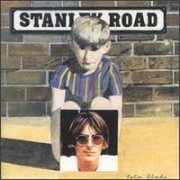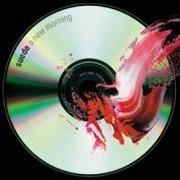 |
|
UK Indie/Britpop and the Mellotron |
In the early '90s, a rather vague movement appeared, growing out of the established 'Indie' scene, dubbed Britpop by the press. It was characterised mainly by a considerable '60s influence and a return to guitar-based music after years of over-produced synthetic pop, and was hailed by many as 'pop's saviour'. For a few brief moments in 1994, no-one knew whether Oasis or Blur would take pop's crown, though with the benefit of hindsight it's strange to think there was ever any doubt. Of course, Oasis' populism won hands down over Blur's (relative) eclecticism and willingness to experiment.
A side-effect of the movement's '60s fixation was the slow but steady appearance in album credits of 'Mellotron played by...'. Ex-Jam/Style Council mainman Paul Weller started the ball rolling on his 1993 effort 'Wild Wood', utilising the instrument on a good half of the album's tracks, repeating the feat on the following year's 'Live Wood' on-stage effort. It's rather ironic that although Britpop was chiefly regarded as a young musicians' thing, the wrong-side-of-30 Weller laid the groundwork for the movement, inspiring many of its main movers and shakers. Strictly speaking, Weller cannot really be described as Britpop, or even Indie, but without his 'dadrock' influence it may all have turned out rather differently.
Oasis kicked things off properly with '95's '(What's the Story) Morning Glory', notably on major hit 'Wonderwall'. For any doubters re: the 'real or Mellotron cellos' debate, wind your CD to about 4.12, where if you listen closely you can hear the sound choke off at the end of the tape. The other contenders for 'first '90s use' were Pulp. Despite having a classic monosyllabic Britpop name, Pulp had been in existence for a good decade, and had a good few rather unsuccessful albums under their collective belts. Their star was already on the rise, but in 1995 their time finally came, as the superb '60s-influenced pop of 'Different People' finally broke the band to a wider audience. Its parent album, 'Different Class', featured various band members on a raft of vintage gear, including oddly charismatic vocalist Jarvis Cocker on Mellotron. It's only really apparent on a couple of tracks, but the band's dense sound means there could be more hidden away in the mix somewhere. Paul Weller released another 'Tron-laden album that year with the critically acclaimed 'Stanley Road'. More dadrock ensued.
'96 only seems to have coughed up Denim's On Ice, although Blur used samples here and there too.
1997 brought seemingly dozens of new contenders, however. Suede's 'Coming Up' let a little 'Tronness creep onto one track, but The Verve's much-lauded 'Urban Hymns' featured it on a couple of songs, albeit uncredited. Oasis' 'Be Here Now' allegedly features Mellotron , but fairly close scrutiny failed to pick any out; another case of 'buried in the mix', I suspect. Two lesser names, the Seahorses and Rialto both used the instrument quite openly, but it didn't seem to do much for their careers.
One big name to unashamedly nail the Mellotron colours to their mast that year was Radiohead. Strictly speaking, not Britpop at all, but lazy articles like this one have tended to lump them in with their poppier cousins. Their previous effort, 'The Bends' picked up rave reviews across the board, but 'OK Computer' was an altogether darker thing, provoking 'the new prog' comments in the press. Strangely, this did the band no harm whatsoever, and the album sold by the truckload. None of the album's singles featured the instrument, but it crops up on several tracks, particularly utilising the classic 8-voice 'choir' sound.
A new name appearing that year also cheerfully namechecked their 'Tron in the liner notes: Mansun. Also hailed as 'the new prog', their unusual approach seems to be along the lines of 'write loads of short, indie-ish bits, then nail them all together and insert fairly arbitrary track breaks'. While the Mellotron was only occasionally apparent, a short biography of the band written after their second album mentioned how guitarist Paul Draper 'has a Mellotron in his kitchen. He uses it for sound effects and stuff'. Quite how he came to have a set of sound effects tape, or even one track of them is unknown, but it makes for unusual use of the instrument. The effects tend to be slipped in between tracks, although it's extremely difficult to work out which are Mellotron, and which just samples.
Another big name whose Mellotron use remains unconfirmed are the quite interesting Supergrass. Their albums feature loads of (real) Hammond, with other analogue stuff inserted here and there, but despite rumours, there's no obvious 'Tron anywhere.
In 1998, Pulp put more 'Tron onto the rather darker 'This is Hardcore', although the standard problem of 'is it effected Mellotron or just a generic string sample' tends to apply. Bernard Butler, ex-Suede put some on his 'People Move on' album, but it didn't make it any more interesting. Mansun's confusingly named 'Six' made no mention of Mellotrons in the sleevenotes, and there aren't any obvious string sounds, but there may well be more of their special effects tapes. Hard to tell.
By 1999, a bit of a let-up in Mellotron use could've been expected, but instead the reverse has applied. The Charlatans, always Hammond freaks, bought a black M400 and recorded and toured with it ('Us & Us Only'). Ocean Colour Scene had also been around for a while, but their 'One From the Modern' has some very nice 'Tron parts. A newer name, Gomez used a Mellotron on only one track on their second album, 'Liquid Skin', but they turned up on 'Later With Jools Holland' with a white M400, personally introduced by their host. Strange... They've since bought their own machine, so expect more Gomez 'Tron-ness in future. Stereophonics found room for one on a couple of tracks of their 'Performance & Cocktails', and Ultrasound, yet another 'new prog' contender bought a 'Tron and plastered it all over their 'Everything Picture'. Gay Dad are supposed to have used one on 'Leisure Noise', but it's pretty well buried if they have.
By early 2000 it was finally time for a new Oasis album, although their star would appear to be on the wane, at least critically. The grammatically-dodgy 'Standing on the Shoulder of Giants' featured Mellotron on several tracks, notably first single 'Go Let it Out'. Noel apparently now owns two machines; a white Mk.II (actually an FX machine with new tapes) and a Dave Kean Mk.VI. Hard to tell which is used on the album, given that the Mk.II has a full set of custom tapes including loads of M400 sounds. Unlike the Charlatans, Oasis elected not to tour with either of their machines. A cop-out? Do you blame them?
Gomez put some 'Tron on their 'Machismo' EP, and Paul Weller put loads onto 'Heliocentric', after his back-to-basics 'Heavy Soul' of a couple of years earlier. There's a new Mansun album out in 2000 too, but whether or not it's seen any Mellotron action remains to be seen.
Discography
Paul Weller
 |
Wild Wood; 1993 |
 |
Live Wood; 1994 |
 |
Stanley Road; 1995 |
 |
Heliocentric; 2000 |
 |
Illumination; 2002 |
Oasis
 |
(What's the Story) Morning Glory; 1995 |
 |
Be Here Now; 1997 |
 |
Standing on the Shoulder of Giants; 2000 |
 |
Heathen Chemistry; 2002 |
 |
Don't Believe the Truth; 2005 |
Pulp
 |
Different Class; 1995 |
 |
This is Hardcore; 1998 |
 |
We Love Life; 2001 |
Denim
 |
On Ice; 1996 |
Suede
 |
Stay Together; 1994 single |
 |
Coming Up; 1997 |
 |
A New Morning; 2002 |
The Verve
 |
Urban Hymns; 1997 |
Seahorses
 |
Do it Yourself; 1997 |
Rialto
 |
Rialto; 1997 |
Radiohead
 |
OK Computer; 1997 |
Mansun
 |
Attack of the Grey Lantern; 1997 |
Bernard Butler
 |
People Move on; 1998 |
Charlatans
 |
Us & Us Only; 1999 |
 |
Wonderland; 2001 |
Ocean Colour Scene
 |
One From the Modern; 1999 |
 |
Hyperactive; 2005 |
Gomez
 |
Liquid Skin; 1999 |
 |
Machismo (EP); 2000 |
 |
Abandoned Shopping Trolley Hotline; 2000 |
Stereophonics
 |
Performance & Cocktails; 1999 |
 |
You Gotta Go There to Come Back; 2003 |
Ultrasound
 |
Everything Picture; 1999 |


































